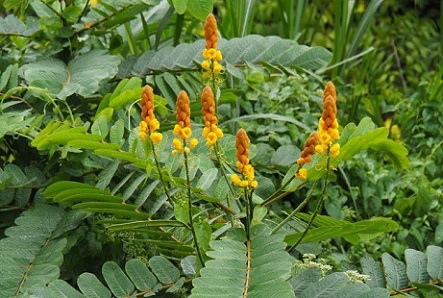Herbs And Phytochemicals: Malaysian Scientists Using Cassia Alata To Revolutionize Wound Healing
Nikhil Prasad Fact checked by:Thailand Medical News Team Jun 10, 2024 1 year, 6 months, 1 week, 4 days, 14 hours, 43 minutes ago
Herbs And Phytochemicals: Cassia alata, a traditional herb known for its remarkable medicinal properties, is gaining attention as a natural remedy for wound healing. Commonly referred to as candlebush, this plant is recognized for its anti-inflammatory, antibacterial, and antifungal capabilities. Malaysian researchers are now exploring its potential in enhancing the wound healing process, making it a promising candidate in natural medicine.
 Malaysian Scientists Using Cassia Alata To Revolutionize Wound Healing
Malaysian Scientists Using Cassia Alata To Revolutionize Wound Healing
Understanding Wound Healing
Wound healing is a complex process involving four main stages: hemostasis, inflammation, proliferation, and tissue remodeling. Each stage plays a crucial role in restoring the skin's protective barrier and functionality.
-Hemostasis: This initial phase involves the formation of a platelet plug at the injury site, followed by a fibrin clot that temporarily restores the skin barrier and stops bleeding.
-Inflammation: Local immune cells, including mast cells and macrophages, release pro-inflammatory cytokines that recruit neutrophils and macrophages to the wound site. These cells clean up debris and release growth factors essential for tissue repair.
-Proliferation: This phase is characterized by the formation of granulation tissue, re-epithelialization, and the growth of new blood vessels. Fibroblasts and keratinocytes play vital roles in closing the wound and rebuilding the epidermis.
-Tissue Remodeling: The final phase involves strengthening and reorganizing new tissue to restore its normal structure and function, primarily through the deposition and remodeling of collagen.
Cassia Alata's Healing Power
Cassia alata contains various phytochemicals, including kaempferol, apigenin, quercetin, rhein, and rutin. These compounds contribute to its wound healing properties through multiple mechanisms.
Key Phytochemicals and Their Roles
-Kaempferol
Kaempferol, a flavonoid found in Cassia alata, exhibits significant wound healing activity. It enhances cell proliferation, migration, and angiogenesis, promoting faster wound closure and tissue regeneration. Additionally, kaempferol's anti-inflammatory properties help reduce inflammation, facilitating the healing process.
-Apigenin
Apigenin is another potent flavonoid in Cassia alata. It has been shown to improve wound healing by promoting cell migration and proliferation. Apigenin's antioxidant and anti-inflammatory effects further enhance its wound healing capabilities, making it effective in both normal and diabetic wound models.
-Quercetin
Quercetin plays a crucial role in wound healing through its anti-inflammatory, antioxidant, and angiogenic properties. It promotes the proliferation of fibroblasts and keratinocytes, essential for tissue repair and regenerati
on. Quercetin also regulates key pathways involved in inflammation and tissue remodeling, aiding in faster wound recovery.
-Rhein
Rhein, an anthraquinone in Cassia alata, contributes to wound healing by reducing inflammation and promoting collagen synthesis. Its antimicrobial properties help prevent infections, which can significantly impede the healing process.
-Rutin
Rutin is known for its antioxidant, anti-inflammatory, and antibacterial activities. It enhances wound healing by promoting cell proliferation and migration, reducing oxidative stress, and improving collagen synthesis. Rutin's ability to modulate key signaling pathways further supports its role in wound repair.
Clinical Evidence and Research
Numerous studies have highlighted Cassia alata's effectiveness in wound healing. In vitro and in vivo models have demonstrated its ability to accelerate wound closure, reduce inflammation, and enhance tissue regeneration.
-In Vivo Studies: Research on rodent models has shown that Cassia alata extracts significantly increase the rate of wound healing, reduce the period for re-epithelialization, and promote wound contraction. These effects are attributed to the plant's rich phytochemical composition.
-In Vitro Studies: Cell proliferation and migration assays have revealed that Cassia alata extracts enhance the proliferation of human dermal fibroblasts and keratinocytes. These findings support its potential as a natural wound healing agent.
Traditional Uses and Modern Applications
Traditionally, Cassia alata has been used to treat various skin ailments, including eczema, ringworm, and itching. Its medicinal properties extend beyond wound healing, offering antifungal, anti-inflammatory, and analgesic benefits. Modern research is now validating these traditional uses, providing a scientific basis for its efficacy. The Malaysian
Herbs And Phytochemicals study team are working on creating a new applicable form by using extracts from Cassia alata and nano technology so that the bioactive complex can be applied directly on wounds.
Future Prospects
The promising results from studies on Cassia alata suggest its potential for development into therapeutic products for wound care. Its natural origin and multifaceted healing properties make it an attractive alternative to synthetic drugs.
Conclusion
Cassia alata stands out as a powerful natural remedy for wound healing. Its rich phytochemical profile, including kaempferol, apigenin, quercetin, rhein, and rutin, offers a multifaceted approach to enhancing the wound healing process. As research progresses, this traditional herb could become a cornerstone in natural wound care, providing a safe and effective solution for various skin injuries.
The study findings were published in the peer reviewed journal: Sci
https://www.mdpi.com/2413-4155/6/2/34
For the latest on
Herbs And Phytochemicals, keep on logging to Thailand Medical news.
Read Also:
https://www.thailandmedical.news/news/medical-news-uk-study-find-that-casein-peptides-found-in-milk-aids-in-wound-healing
https://www.thailandmedical.news/news/south-korean-scientists-discover-that-extracellular-vesicles-of-the-microlagae-euglena-gracilis-aids-in-skin-regeneration-and-wound-healing
https://www.thailandmedical.news/news/new-next-generation-wound-gel-that-treats-and-prevents-infections-including-those-caused-by-multi-resistant-bacteria
https://www.thailandmedical.news/news/canadian-healthtech-startup,-moleculite-receives-us-fda-approval-for-wound-imaging-medical-device
https://www.thailandmedical.news/news/researchers-discover-epigenetic-enzyme-that-can-aid-in-diabetic-non-healing-wounds
